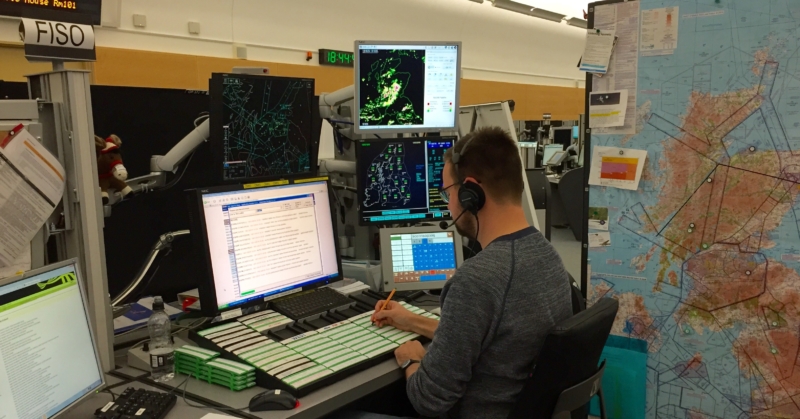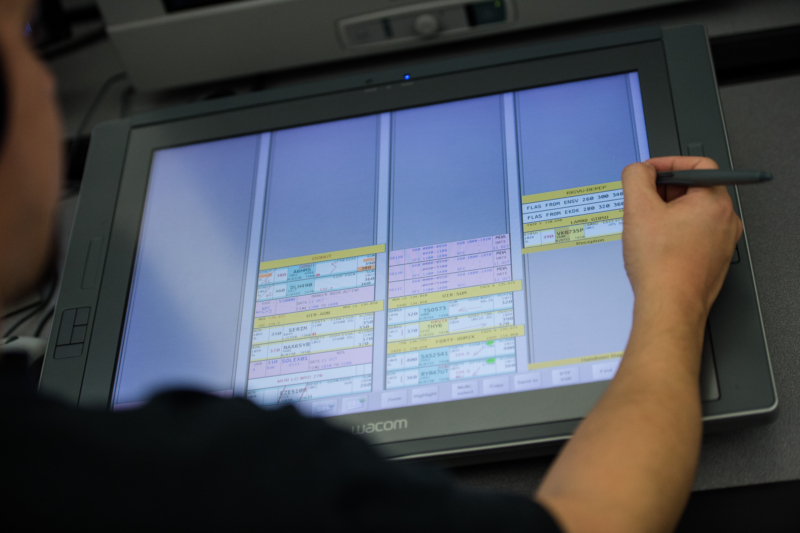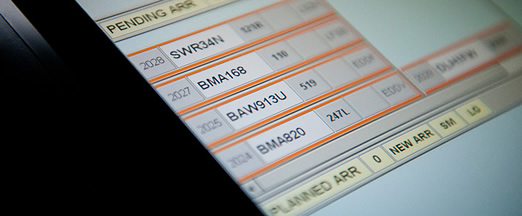Anatomy of a flight strip – The Scottish FIR Perspective
23 February 2016Previously an interesting blog by Ady Dolan featured the anatomy of a strip, focusing on Heathrow and the electronic flight strips they use. At the Prestwick Centre the FISOs on the Scottish Information frequency work at the opposite end of the scale, with light aircraft solely outside controlled airspace.
We hand-write the aircraft details on paper strips. Our customers are mainly general aviation pilots, although we also work with helimed and rescue aircraft as well as the occasional commercial flight.
This strip featured was taken from the summer of 2014, when we provided a service to ‘Heritage1’, a Canadian Lancaster bomber that was making its way back to Canada after visiting the airshow circuit.

The layout and content of the strip is the same for every customer we work with, so I will explain the strip from left to right, with the boxes numbered for clarity.
1 – There are three pieces of information here: ‘Heritage1’ is the aircraft callsign, (on Scottish Information this will often just be an aircraft registration such as GMDJE), in the bottom left hand corner is the Scottish Information transponder code (or squawk) 7401 and in the top right hand corner is the aircraft type. I should mention that although we are a non-radar sector we still allocate a squawk to the aircraft we are working with so that the radar sectors and adjacent units know who to contact if they want to talk to the aircraft.

2 – The top box is the departure airfield, in this example RAF Coningsby (EGXC). British airfields all start EG so we only annotate the last two letters. The bottom box is the destination airfield, in this case Keflavik in Iceland.

3 – This is where we annotate the level of the aircraft, ‘1.3’ is altitude 1300ft and at the bottom 1012 is the regional pressure setting the pilot has said he is using. In the bottom right hand corner the ‘V’ indicates the aircraft is flying in accordance with Visual Flight Rules (VFR).

4 – These boxes are used to record the route the aircraft is taking using information provided by the pilot. In this case the pilot didn’t have an accurate position report on first contact, so ‘I/C’ stands for Initial Contact. The second box then has ’20 NTH NT’ which means ‘20 miles north of Newcastle’, then in the final box ‘SAB’ is the reporting point St. Abbs [Head], the small ‘R’ in this box means that the FISO asked the pilot to report passing this point.
4a/b – The split box, below the route, is where we record the time for each point. The upper portion (a) is used for the estimate (if given by the pilot) and the lower box (b) is used for the actual time, so we can see that ‘Heritage1’ first called on frequency at 1028, verified his position at 1031, then reported passing St. Abbs at 1040.

5 – This box contains any additional information relevant to the flight. In the case of ‘Heritage1’, the ‘QL’ with a tick indicates that the FISO passed the aircraft details on to RAF Leuchars as they were the next unit to work with the aircraft. The hash followed by 7405 is the squawk allocated to the aircraft from RAF Leuchars, which the FISO will have passed to the aircraft when it reported at St. Abbs prior to transfer. Below this is the RAF Leuchars frequency followed by the time the aircraft was transferred, 126.6/40. Finally, BS stands for Basic Service and is annotated on all FISO strips when the aircraft is offered a Basic Service.

As you can see we record a fair amount of information on our FIR strips, but the big difference from Ady’s, and all other electronic strips, is that ours are still handwritten. Where possible, FISOs try to note down on the flight strip all the relevant information on the first call with an aircraft. However, pilots do not always provide us with all the information we require.
If you fly regularly and speak to Scottish or London Information, please try to have the following information to hand and ready to pass onto them in a clear and well-paced manner:
Callsign
Aircraft type
Departure airfield
Destination airfield
Present position and level (with pressure setting)
Intended routeing
Flight rules (VFR/IFR)
For example, one of our regular customers the Loch Lomond Seaplanes C208 floatplane would call us as follows; “GMDJE, a Cessna 208, Loch Lomond to Loch Lomond, overhead Alexandria 4 thousand feet on 1012, routeing Crinnan, Gigha, Rothesay then back to Loch Lomond, VFR, requesting a Basic Service.”
A well-paced message allows the FISO to complete the strip in one go, and saves time in the long run compared to talking fast and having to clarify or repeat information, remember we are writing as the pilot is talking!
If you are flying in the Scottish FIR at, or below, FL55 and outside controlled airspace, then give Scottish Information a call on 119.875mhz, we’re always happy to hear from you! You can also follow us on Twitter: @NATSScotInfo.
Comments
Please respect our commenting policy and guidelines when posting on this website.



23.02.2016
15:03
Donald Bagwell
I would think it would allow for record keeping, for statistical analysis; to just use electronic flight progress strips, even on the GA level. in the daytona beach fl area; where the airspace is full of flight training; some ways of looking into optimization can be gained from electronic records of all flights; I do believe all audio is currently saved…
24.02.2016
12:02
Donald Bagwell
I was curious as to the time frame for comment approval and posting; I posted a comment over 24 hours ago; and don’t see it..
26.02.2016
16:38
Jake Barley
Flight Information Service OfficerDonald – thanks for your comment. During the introduction of electronic flight strips at Prestwick Centre a few years ago the FISOs were involved in testing whether Scottish Information could be handled using electronic flight strips, and it was found that the hand writing function on the electronic panel was not good enough to keep pace with the volume and frequency of traffic calling up on a busy day.
As the FISOs on Scottish Information only work aircraft outside controlled airspace, there is no requirement for optimisation as technically pilots can do what they want, when they want, where they want; they do not even have to talk to us if they choose not to. It will be interesting to see what the future holds as advancements in technology allow hand writing on electronic devices to become more fluid and immediate, akin to writing on paper.
16:38
Jake Barley
Flight Information Service Officer04.03.2016
03:01
Stewart Kettles
Great guys, were always helpful to us students flying out of EGPK